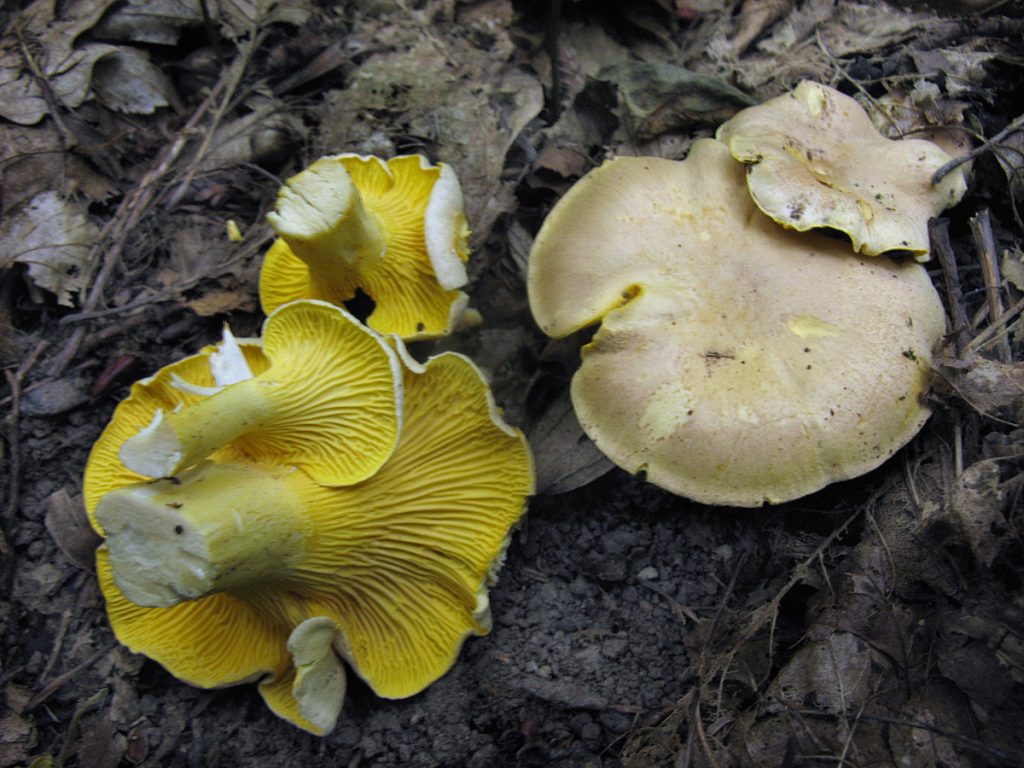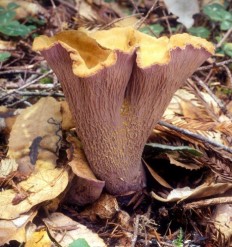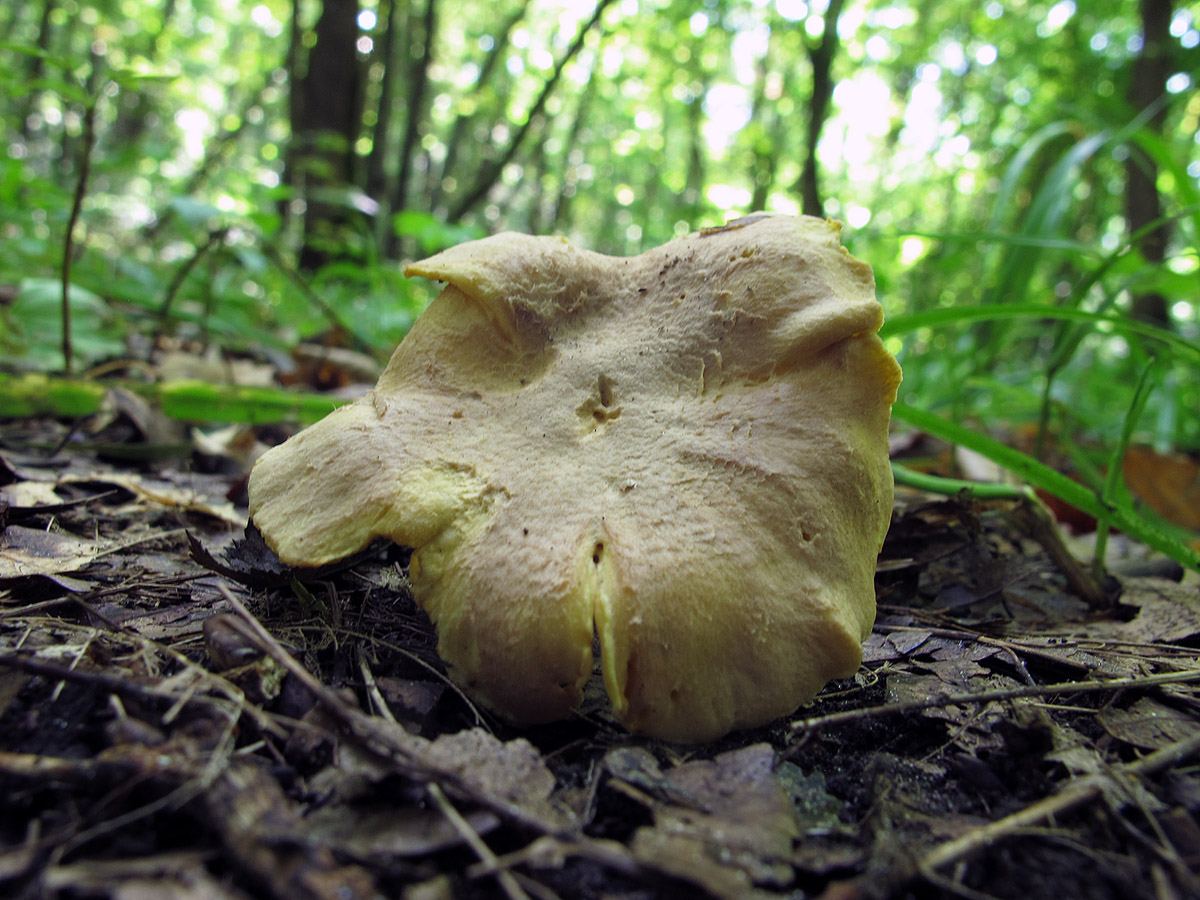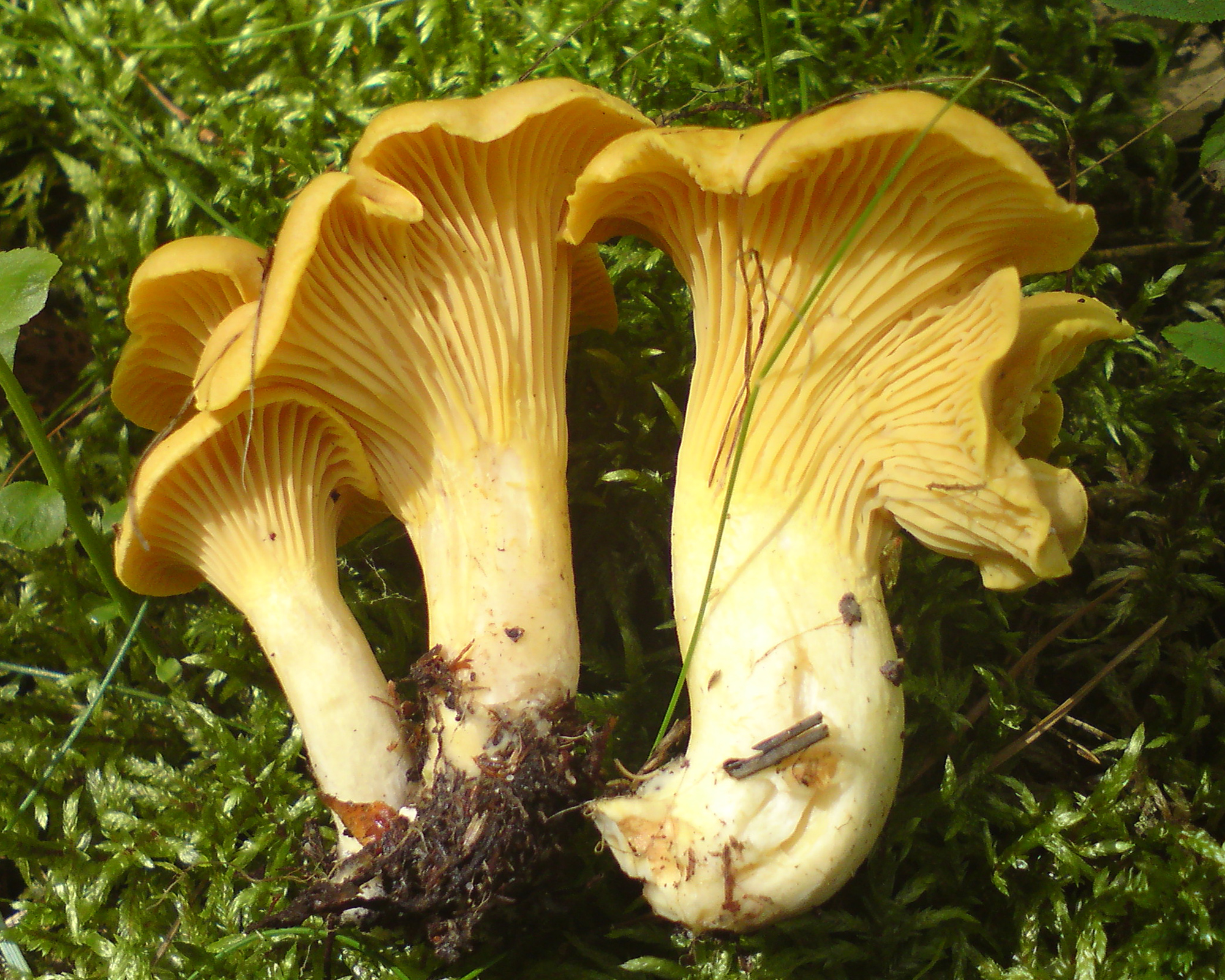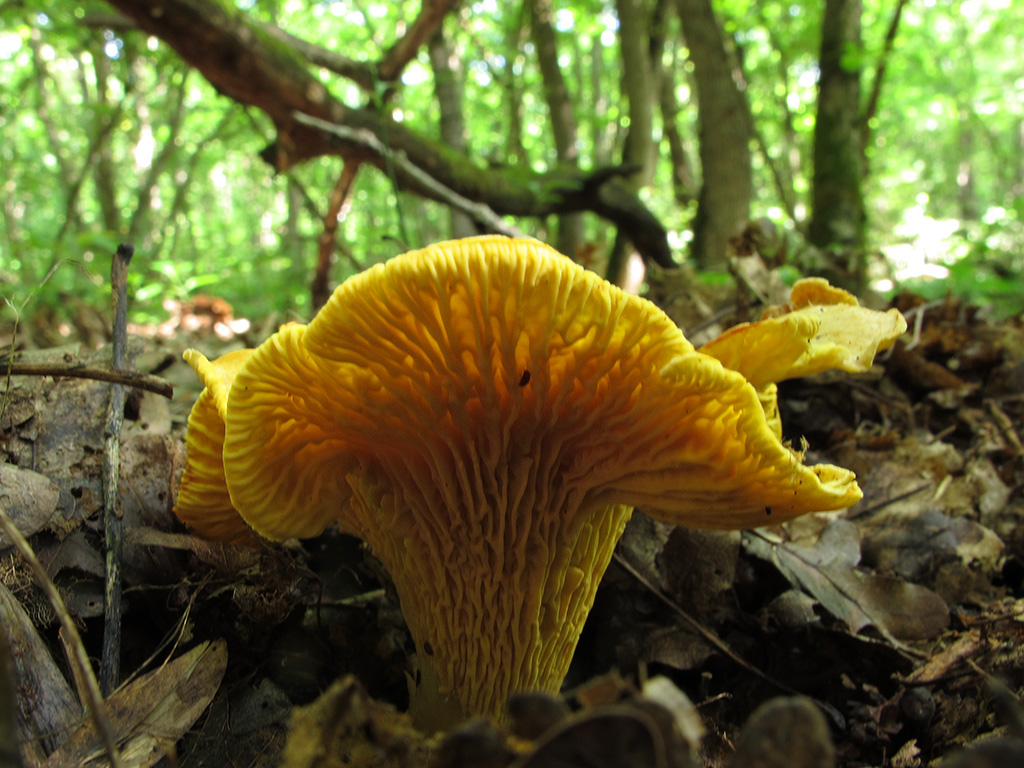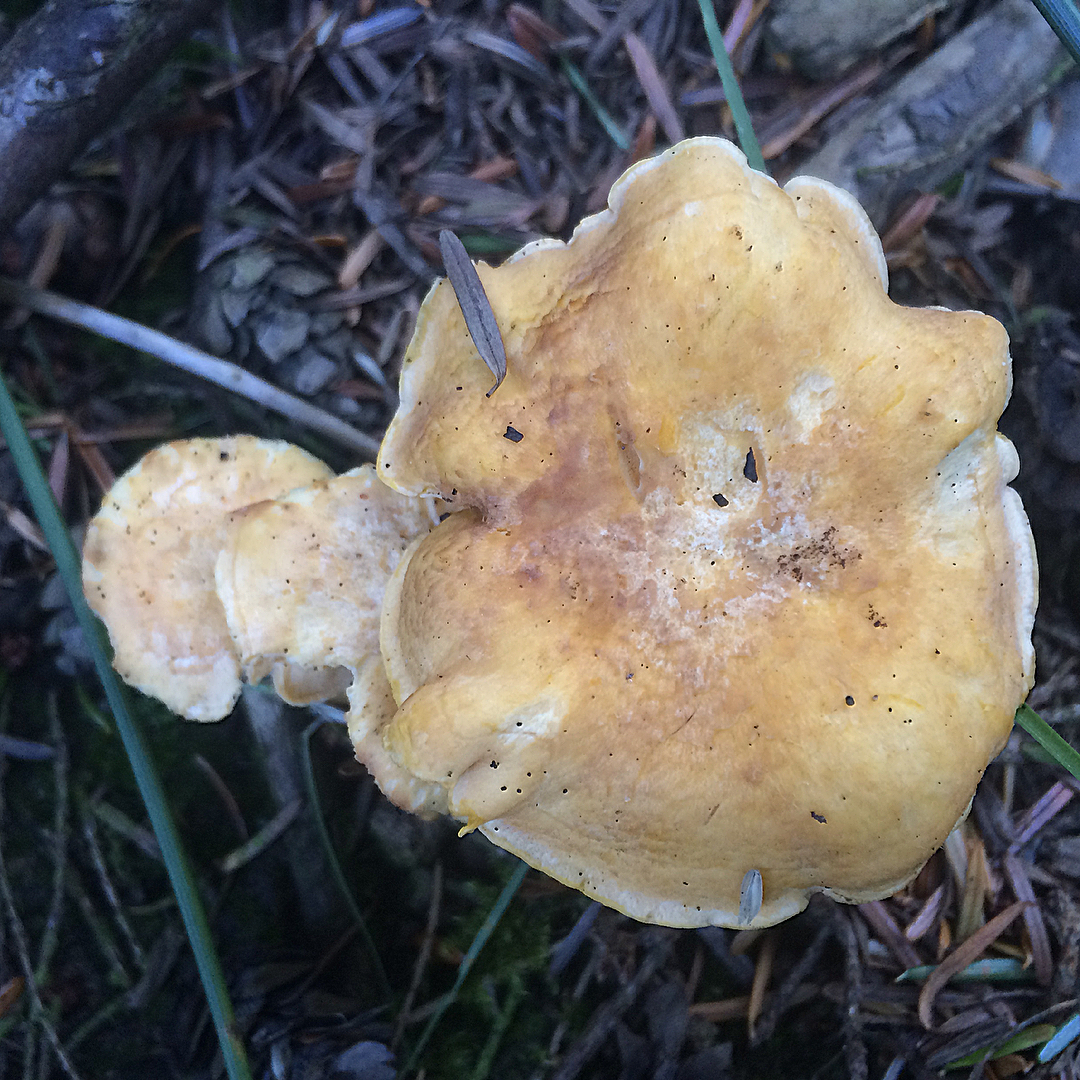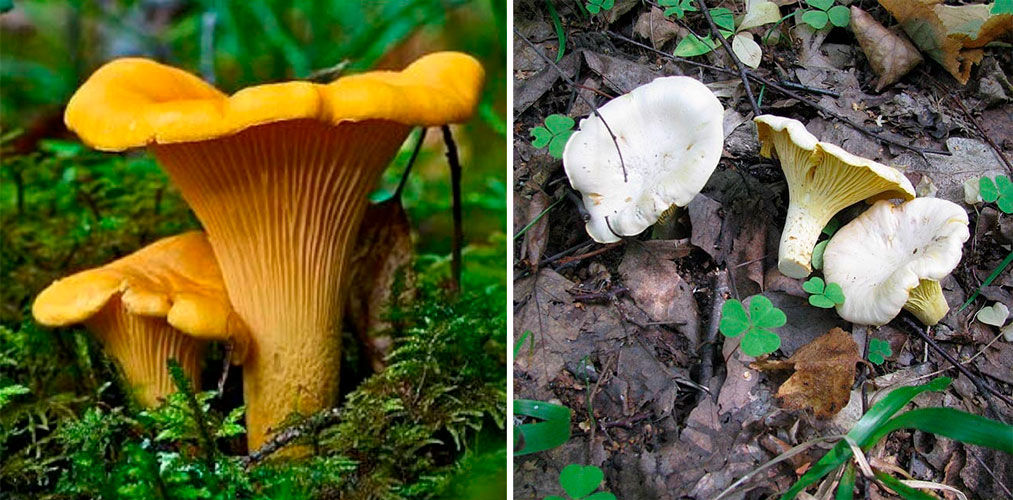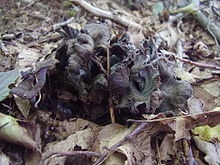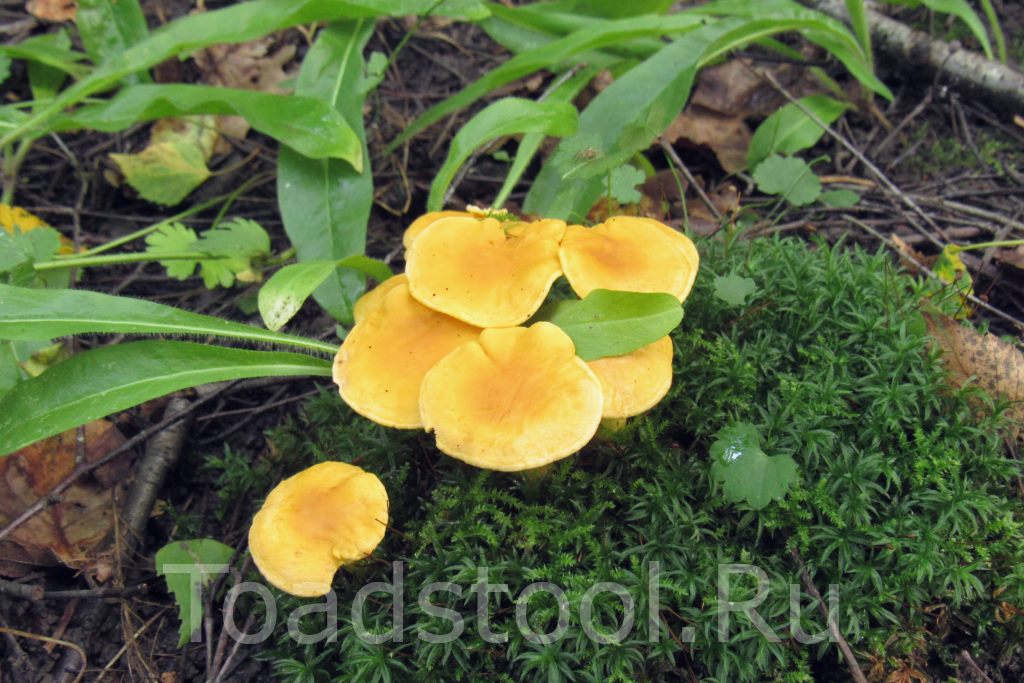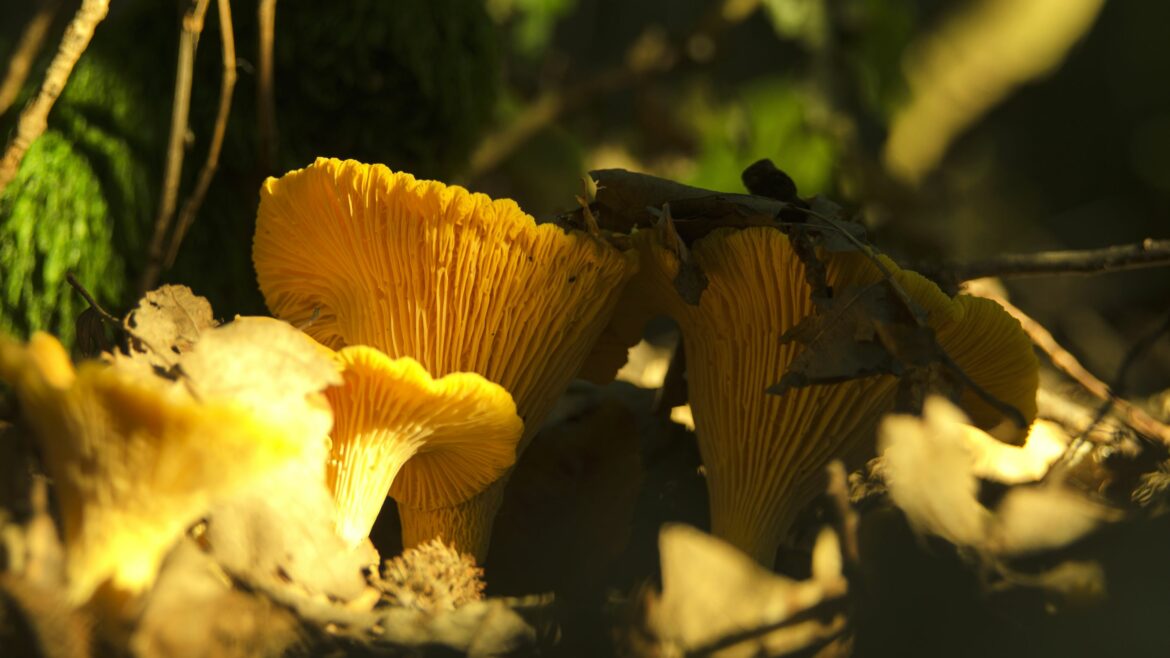Scaly homphus (Turbinellus floccosus)
Synonyms:
- Gomphus floccosus;
- Cantharellus floccosus;
- Merulius floccosus;
- Turbinellus floccosus;
- Chanterel floccosus;
- Nevrophyllum floccosum;
- Neurophyllum floccosum;
- Turbinellus floccosus;
- Cantharellus canadensis;
- Cantharellus princeps.
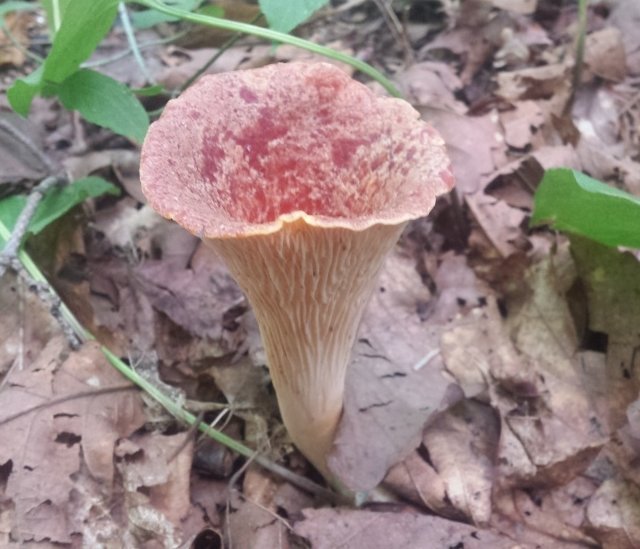
For its rather unusual appearance, Scaly Gomfus (Variegated Chanterelle) regularly falls into various top 10 "Most beautiful mushrooms in the world", "Most unusual mushrooms" and even "The most incredible mushrooms in the world." Naturally, the constant mention in such charts makes many mushroom pickers want to find this mushroom. Unfortunately, there is no need to go further than "find, look and photograph": the mushroom is not recommended to be eaten due to the fact that it can cause digestive upset. There is information ("Poisonous mushrooms of Russia" - Vishnevsky MV) that it contains a toxin, a resinous norkaperatic acid, which provokes the development of gastroenteritis. Meanwhile, in the markets in Mexico, according to information from the same book, Scaly Gomfus is sold as a completely edible mushroom.
Description:
Ecology: Forms mycorrhiza with conifers, grows singly or in small groups, on soil, in coniferous and mixed forests.
Season: Summer - Autumn (July - October).
The fruit body is most similar in shape to a vase. Quite fleshy, 6-14 cm in height and 4-12 cm in diameter.
The upper surface of the cap: Cup-shaped, funnel-shaped, sometimes rather deeply pressed, for which the mushroom is sometimes called "mushroom-pipe" and "mushroom-jug". Wet in young mushrooms, covered with pressed soft scales of approximately the same size. This furry gave the mushroom several more names: furry, scaly or woolly chanterelle. But these names are not used very often, perhaps because the mushroom itself is quite rare (although there is mentions that it is found quite often in North America, the Far East and South Siberia). The color can range from dark orange to reddish orange or brownish orange, with yellowish spots and patches. The edge is thin and wavy.
Lower surface: deep down, almost to the very base of the peduncle, covered with fine longitudinal wrinkles and folds. The folds are often bifurcated and / or crossed. In young mushrooms, creamy, creamy white, discolored with age, becomes brownish when ripe.
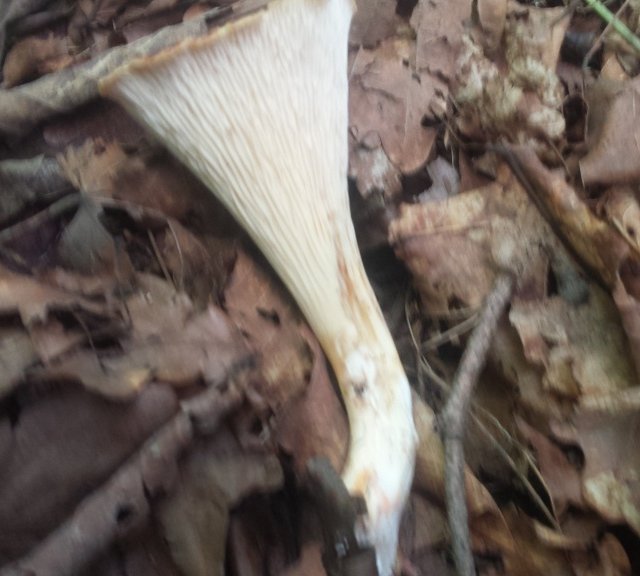
Leg: 4-10 cm in height and 2-3.5 cm in width. Conical in shape, narrowed towards the base. The transition between the leg and the cap is practically indistinguishable. The color at the stem is like the underside of the cap, creamy, or with dull yellow tints.
Pulp: from white to off-white, according to some sources - orange-yellowish. Fibrous. Does not change color on the cut.
Smell: very weak mushroom.
Taste: sweet, sweet and sour.
Spore powder: ocher yellow.
Microscopic characteristics: spores 11-17 * 5.5-8 microns, elliptical with a snout-shaped apical end, finely warty.
Edible: as mentioned above, the mushroom is not recommended to be eaten.
Similar species are mentioned:
Gomphus bonarii is bright red in color with white hymenophore folds and with more pronounced scales or growths on the top of the cap.
Gomphus kauffmanii is larger, scaly, more yellow in color.
Note: my attempts to find out what kind of animal this "norkaperatic acid" is, have led nowhere. Search engines give out this name only on a few sites related to medical topics, in the sections on medicinal mushrooms, and in the specified book. Neither a normal Latin name nor a description has yet been found. However, I didn't really want to.
Chanterelle species, appearance
The chanterelle tubular, or funnel-shaped (Cantharellus tubaeformis) belongs to the Chanterelle family, popularly called the chanterelle, cantarella.

The genus of chanterelles is very large, varieties and types of mushrooms (tubular and lamellar) from the Chanterelle family:
- The tubular chanterelle has very small cap sizes, they rarely exceed 5-6 cm in diameter, the cap forms a narrow funnel, its color can be yellow, reddish, brownish. The leg is hollow, very long (up to 10 cm), sometimes slightly compressed from the sides.The white pulp has a slightly bitter, pleasant taste, it smells slightly of plums (Mirabelle variety). Funnel-chanterelle mushrooms (photos, pictures, see the section of 50 pictures) usually grow in very dense clusters, one next to the other.
- The chanterelle (real) is a mushroom with a cap reaching 12 cm in diameter, the edges are wavy, in the center of the cap there is a funnel-like depression. The color of the cap and the leg is the same - yellow in different shades. The flesh of the cockerels is dense, fleshy, the smell is slightly sour, reminiscent of the smell of dried fruits. The pressed places turn a little red. The plates are wide, rather thick, have the same color as the whole mushroom. Mushrooms are rarely wormy, the substance quinomannose in the pulp inhibits the vital activity of pests. The real chanterelle grows in groups on all continents in a temperate climate, in coniferous forests, in mixed massifs.
- Chanterelle pallor (white) is very similar to the real one, differs from it in a more faded color (sometimes even white) of the fruit body. It grows at the same time in similar areas, although it prefers deciduous forests over spruce forests.
- The chanterelle is gray in the shape of the fruiting body, similar to a real chanterelle, it differs in the color of the cap, it is gray, brown, ashy, the bottom of the cap is usually slightly lighter. The cap is wrinkled, the edges are twisted.
- The amethyst chanterelle grows to a large size (up to 10 cm in diameter), the yellow color of the cap is diluted with spots of purple scales, which are denser at the center of the depression. It acquires the shape of a funnel after it has passed the young stage of growth. The leg is dense, with a diameter that decreases towards the ground. Quite a rare species that prefers mixed forests, massifs of broad-leaved trees. Often adjacent to beech, found in southern Russia from mid-summer to late autumn. It grows in circles, in large families.
- The type of chanterelle is velvety, Frieza (orange funnel), this species pleases the eye with a bright orange (sometimes with a reddish tint) color of the cap. The species is rare. The pulp is slightly bitter, with a pleasant aroma. Grows on acidic soils of southeastern Europe, in July-October.
- The species horn-shaped funnel, or black chanterelle, a mushroom (photos and descriptions of this genus are given below), belonging to the genus Funnels, the Chanterelle family, look like narrow black funnels with wavy edges. The stem of the mushroom is very short, it is almost invisible, the height of the cap reaches 12 cm, diameter is up to 8 cm. It grows in the mountainous regions of Europe. Edible.
Also in the family there is a clavate chanterelle species.
What chanterelle mushrooms look like
Representatives of this species have one structural feature: the cap and the leg are a single whole. There is no classic fit of the cap on the detachable leg. The color of the cap and legs is about the same: from light sunny to deep red or even orange.
The cap of the mushroom is flat, it can reach 5-10 cm in diameter. It has curved and wavy edges. You can compare the shape with an umbrella turned inside out. The structure of the mushroom itself is dense and smooth; it is difficult to separate the skin from the pulp.
The edible part of the mushroom is yellowish, sometimes with a white tint. The taste of the pulp is slightly sour, but some talk about a slight aftertaste of dried fruits. The surface takes on a slight red tint when pressed lightly.

The leg has the same shade as the cap. Sometimes it can be slightly lighter. Its length is 5-7 cm, and its thickness is up to 2 cm. The structure is smooth and dense, and the shape of the base is uniform, slightly narrowed downwards.
Application

In cooking
The tubular look is used in all dishes as the common chanterelle. Due to the slight harshness of the pulp, it requires a longer boiling time. The mushroom is dried, used as a component of soups, second courses, sauces, pie fillings, salted and pickled for the winter, and made into mushroom powder.
In medicine
The mushroom is not included in the State Pharmacopoeia of Russia, it is used in non-traditional treatment. In China, Japan, preparations are produced in the form of capsules with anthelmintic chanterelle powder.In Western European medicine, the extract from these mushrooms is used in the treatment of hepatitis C, to cleanse the liver.
The healing properties of the amethyst chanterelle
Amethyst chanterelle is not only edible, but also curative: our ancestors knew about its medicinal properties. Infusions, powder and decoctions from this mushroom, saturated with many vitamins, beneficial acids, minerals and carotenoids - antioxidants, have the following qualities:
- Cancer prevention. Alcoholic infusion of chanterelles is taken to prevent cancer in precancerous conditions.
- Getting rid of parasites. Powder from dried mushrooms containing the enzyme chitinmannose is taken to kill worms.
- Strengthening the immune system. Regular eating of chanterelles improves immunity to colds, strengthens the general tone, and also promotes a speedy recovery from acute respiratory infections and acute respiratory viral infections.
- Heals the liver. The content of ergosterol and trametonolinic acid in the chanterelle has a beneficial effect on liver enzymes, which helps to cure hepatitis, hemangiomas and other liver diseases.
- Eliminates other diseases. Amethyst chanterelles treat dermatitis, furunculosis, tonsillitis and even pulmonary tuberculosis.
Chinese doctors argue that the Amethyst Chanterelle also improves vision, and this is especially true for those who often work at the computer. You just need to eat this mushroom regularly, and it will not only restore visual acuity, but also prevent inflammation of the eyes and mucous membranes.
Amethyst chanterelle
Chanterelle amethyst - Latin Cantharellus amethysteus
Description
External characteristics
Mushroom cap
The chanterelle's cap, reaching 20-100 mm in diameter, at first grows slightly convex, later becomes flat or in the form of a funnel, fleshy, with curled wavy edges.
The hat surface is pale yellow or orange-yellow in color.
The hats are filled with dense yellowish flesh, which brightens as the mushrooms mature. The flesh of older specimens is dry and so firm that it resembles rubber.
The hat bottom is decorated with many branched thick yellowish lamellar veins descending along the legs.
The spore powder is white.
Stipe
Amethyst chanterelle has a cylindrical smooth leg filled with dense, tight pulp. The bottom of the legs is narrowed, the top is widened. The height is 30-70 mm, the thickness is 5-40 mm.
Growing places
This fungus prefers mixed, coniferous and deciduous forests, grows among thin grass and in mossy places. Often found near fir trees, beech, pine, oak, birch.
The chanterelle bears fruit in whole families, forming colonies and "witches" circles. You can harvest chanterelles from June to October, until they are beaten by frost.
Edibility
The pulp of the mushroom, which tastes like dried fruit, is eaten after preliminary boiling. Cooking does not take away its attractive color from the mushroom, if you add lemon juice to the water, and removes bitterness.
It can be fried, stewed, added to soups, stored frozen, and even dried for a delicious and healing mushroom powder.
Similar types and differences from them
This mushroom bears similarities to the following edible cousins:
- The chanterelle is pale. Unlike amethyst chanterelle, it turns powdery white with a pale yellow tinge and rarely bears fruit.
- The chanterelle is yellow. It differs in plates in the form of veins with many crossbars and a lilac fruit body. It exudes a more tangible aroma and has a pronounced taste. More often found under beech trees in the south of Russia.
Chanterelle amethyst - Latin Cantharellus amethysteus
Comparison of real and false chanterelles
Every lover of collecting forest gifts should know what a false chanterelle looks like. To determine the differences, it is necessary to familiarize yourself in detail with each of the types. Such varieties of chanterelles as tubular, gray, white and others do not have twins, but an ordinary cockerel can be confused with an orange talker.
The chanterelle is real
False chanterelle
Despite the fact that edible and false specimens are very similar, an experienced mushroom picker can easily tell them apart. This is where a simple tip from a seasoned forest lover comes in handy. Despite the fact that these are delicious mushrooms, it should be remembered that they have counterparts. I'll tell you how I define chanterelles: you can focus on the color of their hats and the shape of their legs. So, everyone's favorite bettas are distinguished by a muted reddish color.
The surface of their cap is matte, always smooth, the skin almost does not separate from the pulp - thick, juicy, corresponding to the shade of the leg. Sometimes the flesh of the mushroom can be very light, almost white. When broken and pressed, it turns slightly red.
The edges of the cap at a young age are smooth, neatly rounded. As they grow, they bend beautifully, become wavy at the edges, and the fruit body acquires a slightly funnel-shaped shape with a deepened center.
A real chanterelle is capable of growing to a large size. Often there are specimens with a cap diameter of about 10-12 cm.
Chanterelle mushrooms have a thick and strong stem. It expands at the top and merges smoothly into the cap. The color of the fruiting body does not change throughout, it has uniformity. The leg thickness is from 10 to 30 mm, the length is up to 7 cm. It is slightly lighter than the cap.
Males do not have plates, the hymenophore consists of frequent, highly branched folds that descend to the pedicle, making up one whole with it.
The color of the caps of the false chanterelle is brighter than that of the real ones. So, when collecting gifts from the forest, the mushroom picker should be alerted by the yellow or orange, slightly velvety surface of the specimen encountered. The diameter of the cap of the kokoshka does not exceed 6 cm, the plates descend to the stem. They are frequent, thin, bright. The pulp is white or yellow, with a sharp mushroom odor (if the aroma is sweetish, then this also indicates that the specimen belongs to the genus Gigroforopsis).
A pronounced difference between these mushrooms is that they have a rather thin (up to 10 mm) and long (up to 5 cm) stem. It is flat, but rarely curved. Inside - fibrous, with pulp resembling cotton wool. The color of the flesh of the leg does not match the shade of the cap; at the base it is darker (almost black).
Key differences
So, you need to remember the difference between representatives of two types of eukaryotes. They are as follows:
- False chanterelles have a brighter color. Cockerels have a calm reddish tone.
- If the mushroom has a sour taste, and its leg is thick and smoothly turning into a cap, then this is an ordinary chanterelle. Such a mushroom has a slightly curved leg shape. Kokoschki have a thin and hollow stem.
- The chanterelle mushroom grows in large colonies, the kokoschka - almost always single specimens. It can be found on fallen and rotting tree trunks.
- All kinds of worms and larvae are very fond of eating false chanterelles, while cockerels are extremely rarely spoiled by insects. The only worm that can be found when cutting the fruit body of a cockerel is the wireworm. This fact is explained by the presence of a large amount of chitinmannose in the fruiting bodies of common chanterelles.
- Another difference is that false eukaryotes have an easily peelable skin. When it is removed, the rough surface of the cap is exposed. It is almost impossible to peel off the skin of cockerels.
- In orange talkers, the color of the plates is brighter than the tone of the cap, while in roosters it is uniform and uniform over the entire surface.
These are the main characteristics that show how one species differs from another.
False doubles
Fortunately, the tubular chanterelle does not have poisonous twins, even if a similar species gets into the basket by mistake, there will be no poisoning. Similar in appearance are the yellowing chanterelle and the gray funnel. They all have a funnel-shaped cap. In order not to confuse them, carefully examine the photos.
Characteristics of different types of chanterelles
| Chanterelle tubular | Chanterelle yellowing |
Funnelman | |
| Pulp | White | Light beige, light orange | Dark gray, dark black |
| Hymenophore | Folded | Poorly prominent, lamellar | Smooth, no plates |
| Color | Yellow | Yellow brown | Dark, dull |
| Leg | Tubular | Spongy, hollow | Hard |








False Chanterelle Recipes

Not only healthy and edible mushrooms can be used to make delicious meals. There are a number of recipes using these edible mushrooms.
Mushroom julienne is especially tasty when cooked in portioned pots. It requires:
- 500 g of mushrooms;
- 1 cup sour cream 15% fat;
- 50 g of hard cheese;
- 2 tablespoons olive oil
- 1 teaspoon flour;
- salt, pepper, seasonings to taste.
Pre-processed mushrooms are poured over with boiling water and allowed to drain. Cut the onion into half rings, the mushrooms into medium-sized strips. First, the onion is lightly fried in a pan, mushrooms are added to them, the mixture is salted, pepper, seasonings are added and stewed until half cooked under the lid. Flour is added to the future dish and, stirring constantly, they wait until it is browned. Mushrooms with onions and flour are placed in pots, filling about 2/3 of the volume. Then they are poured with sour cream and placed in the oven for 5 minutes at a temperature of 180 degrees. After that, the dish is sprinkled with grated cheese and sent back to the oven until the cheese melts. Serve it hot.
Pickled mushrooms are harvested for the winter - such a snack takes pride of place on the tables next to sauerkraut and sour cucumbers. It can also be made from false chanterelles.
For 1 liter of marinade you need:
- 1 teaspoon sugar
- 1/2 tablespoon salt
- 2/3 cup vinegar
- 2 carnation umbrellas;
- 1 bay leaf;
- 3-5 peas of black pepper.
1 kilogram of mushrooms is soaked and boiled in advance, after which it is boiled in new clean water for 30 minutes. The liquid is drained, sugar, salt and spices are added to it. It is better to keep the bay leaf in the marinade for no more than 20 minutes. Next, vinegar is poured into the marinade, the mushrooms, along with the liquid, are sent to sterile glass jars and sealed with lids. The product is stored in a cool, dark place for no longer than 3 months.
Description
The tubular chanterelle (Cantharellus tubaeformis) belongs to the genus Chanterelle, the Chanterelle family. This edible little mushroom has other names as well:
- chanterelle funnel-shaped or funnel-shaped;
- tubular paddle;
- tubular cantarell.
The latter is a transliteration of the Latin name of the heroine of our article, Cantharellus tubaeformis.

- the cap is small, its diameter usually ranges from 2 to 6 cm. In young representatives of this species, it has an even or convex shape, the edges are tucked up. In adult mushrooms, the cap is funnel-shaped, elongated - that is why they look somewhat tubular. The edges are uneven and hang down. The skin is covered with small dark-colored scales, velvety to the touch. The color of the cap varies from yellow-gray to various shades of brown;
- the leg is thin, cylindrical, often curved, sometimes compressed on the sides, tubular, smoothly turning into a cap, which in adults of the species is connected to the upper part of the fungus with a small hole. Its height ranges from 3 to 8 cm, thickness is only 3-8 mm. The color of the surface is yellow or dull yellow, while at the point of transition of the cap to the leg, the shade darkens, which is very noticeable;
- the flesh is firm, but thin, yellowish or white. Has a pleasant aroma and taste. Adult fruiting bodies have an unpleasant taste;
- The hymenophore of a tubular beauty is represented by false plates (veins), folded, branched, slightly descending along the leg. The color of the veins is pale gray, yellowish;
- spores of cream color, elliptical in shape.
Orange talker (Hygrophoropsis aurantiaca)
- Other names for the mushroom:
- False fox
- Kokoschka
Synonyms:
- Gigroforopsis orange
- Kokoschka
- Agaricus aurantiacus
- Merulius aurantiacus
- Cantharellus aurantiacus
- Clitocybe aurantiaca
- Agaricus alectorolophoides
- Agaricus subcantharellus
- Cantharellus brachypodus
- Cantharellus ravenelii
- Merulius brachypodes
Description
Hat: 2-5 centimeters in diameter, under good conditions - up to 10 centimeters, first convex, with a bent or strongly bent edge, then flat-spread, depressed, funnel-shaped with age, with a bent thin edge, often wavy. The surface is finely velvety, dry, velvety disappears with age. The skin of the cap is orange, yellow-orange, orange-brown, the darkest in the center, sometimes visible in weak concentric zones that disappear with age. The edge is light, pale yellowish, fades to almost white.
Plates: frequent, thick, without plates, but with numerous ramifications. Strongly descending. Yellow-orange, brighter than caps, turn brown when pressed.
Leg: 3-6 centimeters long and up to 1 cm in diameter, cylindrical or slightly narrowed towards the base, yellow-orange, brighter than the cap, the same color with the plates, sometimes brownish at the base. Can be curved at the base. In young mushrooms, it is whole, with age it is hollow.
Flesh: thick in the center of the cap, thin to the edges. Dense, somewhat cotton-like with age, yellow, yellowish, pale orange. The peduncle is dense, tough, reddish.
Odor: Faint Taste: Described as slightly unpleasant, subtle.
Spore powder: white Spores: 5-7.5 x 3-4.5 microns, elliptical, smooth.
Season and distribution
The false chanterelle lives from early August to late October (massively from mid-August to the last decade of September) in coniferous and mixed forests, on soil, litter, in moss, on rotting pine wood and around it, sometimes near anthills, singly and in large groups, quite often, annually.
Distributed throughout the temperate forest zone of Europe and Asia.
Similar species
Common chanterelle (Cantharellus cibarius)
with which Govorushka orange intersects in terms of fruiting time and habitat. Easily distinguished by a thin, dense (in a real chanterelle - fleshy and brittle) consistency, a brighter orange color of the plates and legs.
Red chanterelle (Hygrophoropsis rufa)
differs in the presence of pronounced scales on the cap and a more brown central part of the cap.
Edibility
Orange talker has long been considered a poisonous mushroom. Then it was transferred to the category of "conditionally edible". Now many mycologists tend to consider it rather mildly poisonous than edible, even after preliminary boiling for at least 15 minutes. Until doctors and mycologists have come to a consensus on this score, we recommend refraining from eating this mushroom for people with hypersensitivity to mushrooms: there is information that the use of a false chanterelle can cause an exacerbation of gastroenteritis.
And the taste of this mushroom is significantly inferior to the real chanterelle: the legs are hard, and the old caps are completely tasteless, cotton-rubbery. Sometimes they have an unpleasant aftertaste from pine wood.
Video about the orange Govorushka mushroom:
The article uses photographs from questions in recognition: Valdis, Sergey, Francisco, Sergey, Andrey.
Edibility
The common chanterelle is an edible species. The mushroom can be boiled, fried and marinated. Freezing is also acceptable, followed by 2-3 months of storage in the refrigerator. Moreover, this mushroom is suitable for drying. Chanterelles dried at a temperature of + 40 ° C are recommended to be stored in cloth packaging. Even having decreased many times in size, mushrooms retain their bright colors. By the way, after getting into boiling water, the volumes are restored. The calorie content of fresh mushrooms is 23 Kcal per 100 g, while dried mushrooms increase to 261 Kcal / 100 g.
In addition to its unconditional taste, this mushroom also has beneficial properties. It has a high content of copper and zinc, vitamins A, PP, B1 and B2, as well as provitamin D. The substance quinomannose not only repels forest insects, but also fights worms perfectly. True, when salted or cooked, it is destroyed. To expel parasites from the body, you need to eat a raw mushroom, use ground dried as a seasoning, or purchase medications with an extract of Chanterelle.

